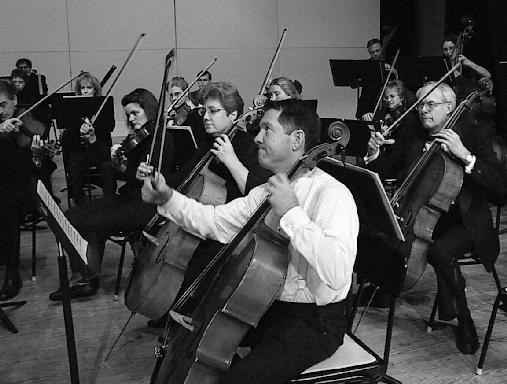

Apr '03 [Home]
Essays

 Apr '03 [Home] Essays Seeing the Orchestra
|
| . | . | . |
Classical music concerts are fun for me these days. I can say this because last summer I learned some important ways to handle the distractions that can pop up with classical audiences, whose members are sometimes guilty of more than just coughing. For example, a year ago in the late spring at an outdoor all-Brahms affair, a man sitting near me did a crossword puzzle; the next week, a woman was knitting her way through Mozart. As a result, long before July 4th, I took Virgil Thomson's advice and closed my eyes at every concert—the better to hear the music without distractions. But this didn't last. I went back to the traditional look-and-listen approach one night after opening my eyes to take a peek at a hells-a-poppin' violin section. One of the violinists was insanely out of tune, and although I couldn't single out the guilty fiddler, a disconcerted clarinetist caught my eye. He was taking a long rest and he was looking at his instrument as if it were in need of repair and, consequently, that when his rest was over he would not be able to play. And yet, what's this? Aha! A few twists to remove some black pipe, a quick blow into the tube that the twisting had revealed… some more twists… and (Whew!) repaired—just in time to come in with the other reed instruments, the players of which had, unlike me, ignored this frantic clarinetist. He probably had these visually-deceptive dramatic episodes all the time, with only non-musicians paying any attention. I kept watching, and I've seen horn players run a piece of cloth through the brass-workings of their instruments. Their rests can be long sometimes, so the brasses are entitled to do a bit of cleaning. Then there came, as it must to all of us (like the death of Charles Foster Kane) that fatal night when the music was not at all worth listening to. I made the best of it by trying to figure out why musicians never turn the pages of their scores at the same time. Pianists, of course, need page-turning help. This seems to be because the piano (with 88 keys) plays a lot of notes and all those notes take a lot of space and therefore there is a whole lot of page turning going on. And (Need we be told?) the pianist only has two hands. Other players in the orchestra obviously use some system or other to decide how often they turn their pages. But it is difficult to break the code; there is no coordination among them and no understandable pattern. How else can you explain the fact that some cellists turn only once during a piece, while others turn their scores four times? And, no mistake about it, both sets of cellists appear to be rocket scientists (like all cellists, male and female) and seem to be playing the same piece. 
Violinists pose the most anarchistic model. Those in the first row of their section may turn once or twice, while those farther back have to double this rate in order to play the same music. The bows all swing back and forth in perfect parallels, but not the pages of their scores. Perhaps the members of the orchestra divvy-up the scores before each concert by tossing dice or cutting cards. Or, maybe if you get back stage early enough, you can go through the scores and see how the pages are laid out. Then, if you are a player who likes to turn, you can take a score that suits you. But, for most musicians turning must be a pain and the early arrivers most likely take those versions of the score that require the least turning. This could explain why when you see a musician arriving late for a performance—literally at the last minute—you will usually find that he or she is not overly concerned and may even be smiling as he or she trots up the steps of the hall. That's because this late player is most likely weary of another bout with, say, Beethoven's Fifth, and has shown up late on purpose to add excitement to the evening—the last score is theirs and it could be, unlike the symphony, a real page turner. Of course, I've never seen a musician smile when turning, though there is a certain smugness that is almost a grin on the face of those string players who turn with their bow instead of their hand. And whatever system the people in the world of the orchestra use, it all works out in the end. They are, alas, not in the dark about what is going on, like those of us who sit in their audiences—eyes closed or eyes open. We can only guess at what their life is like, just as they must sometimes wonder about us, listening to them with such faith, such seriousness, such ignorance, and such bliss. ~ . ~ . ~ |